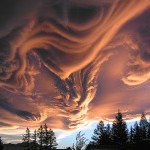Category: Arts
Created by: Donphk
Number of Blossarys: 1
Often referred to as UFOs due their flying saucer shape, lenticular clouds are stationary lens-shaped clouds that form at high altitudes, normally aligned at right-angles to the wind direction. When stable moist air flows over a mountain or a range of mountains, a series of standing waves are often formed on the downwind side. If the temperature at the crest of the wave drops to the dew point, moisture in the air may condense to form lenticular clouds. Under certain conditions, long strings of lenticular clouds can form, creating a formation known as a wave cloud. The wave systems cause large vertical air movements and so enough water vapor may condense to produce precipitation. Since lenticular clouds generally do not form over low-lying or flat terrain, most people have never seen one and are not aware clouds with that shape can exist. Bright colors (called irisation) are sometimes seen along the edge of lenticular clouds. These clouds have also been known to form in cases where a mountain does not exist, but rather as the result of shear winds created by a front.
Oft bezeichnet als UFOs durch ihre fliegende Untertasse Form, sind linsenförmige Wolken stationäre diskförmige Wolken, die in großen Höhen, normalerweise rechtwinklig zur Windrichtung ausgerichtet zu bilden. Wenn stabiler feuchter Luft über einen Berg oder eine Reihe von Bergen fließt, wird eine Reihe von stehenden Wellen oft auf der Lee-Seite gebildet. Sinkt die Temperatur auf dem Kamm der Welle, den Taupunkt, kann Feuchtigkeit in der Luft zu Formular linsenförmige Wolken kondensieren. Unter bestimmten Bedingungen können sich lange Strings linsenförmige Wolken bilden, erstellen eine Formation, bekannt als eine Welle-Wolke. Die Welle-Systeme verursachen große vertikale Luftbewegungen und also kann genügend Wasserdampf kondensieren, um Niederschlag zu produzieren. Da linsenförmige Wolken im Allgemeinen nicht über tiefliegende oder flache Gelände gehören, die meisten Menschen haben schon und werden nicht bewusst Wolken mit dieser Form vorhanden. Helle Farben (Irisation genannt) werden manchmal am Rand des linsenförmige Wolken gesehen. Diese Wolken sind auch bekannt, zu bilden, in Fällen, wo ein Berg nicht vorhanden ist, sondern als das Ergebnis der Scherung Winde erstellt von einer Front.


 English (EN)
English (EN) 